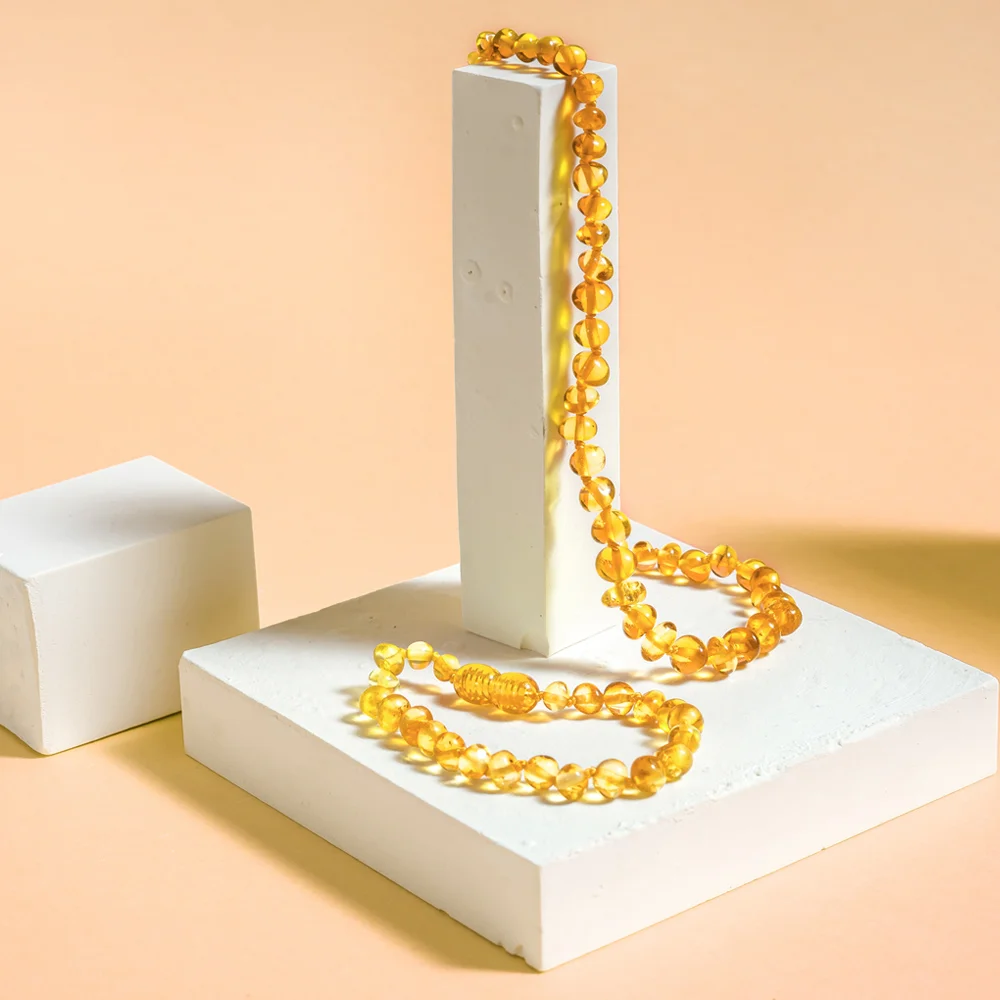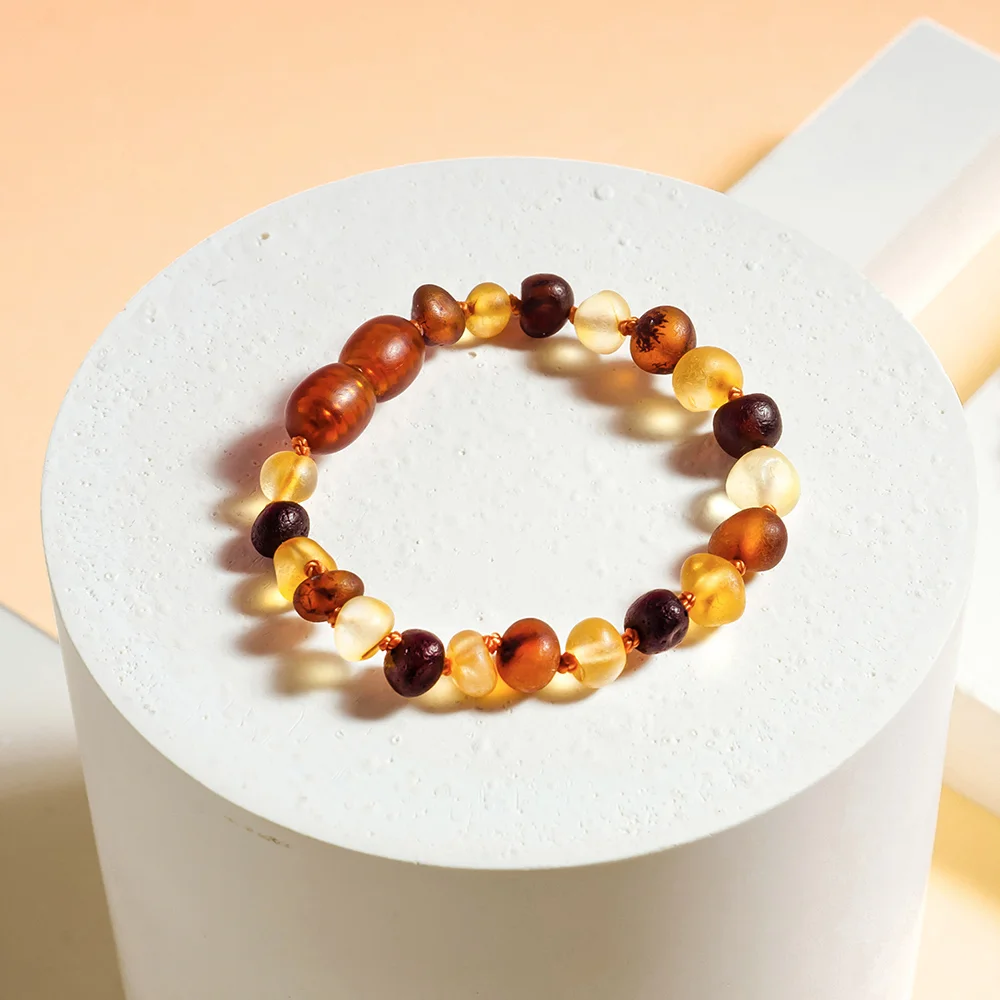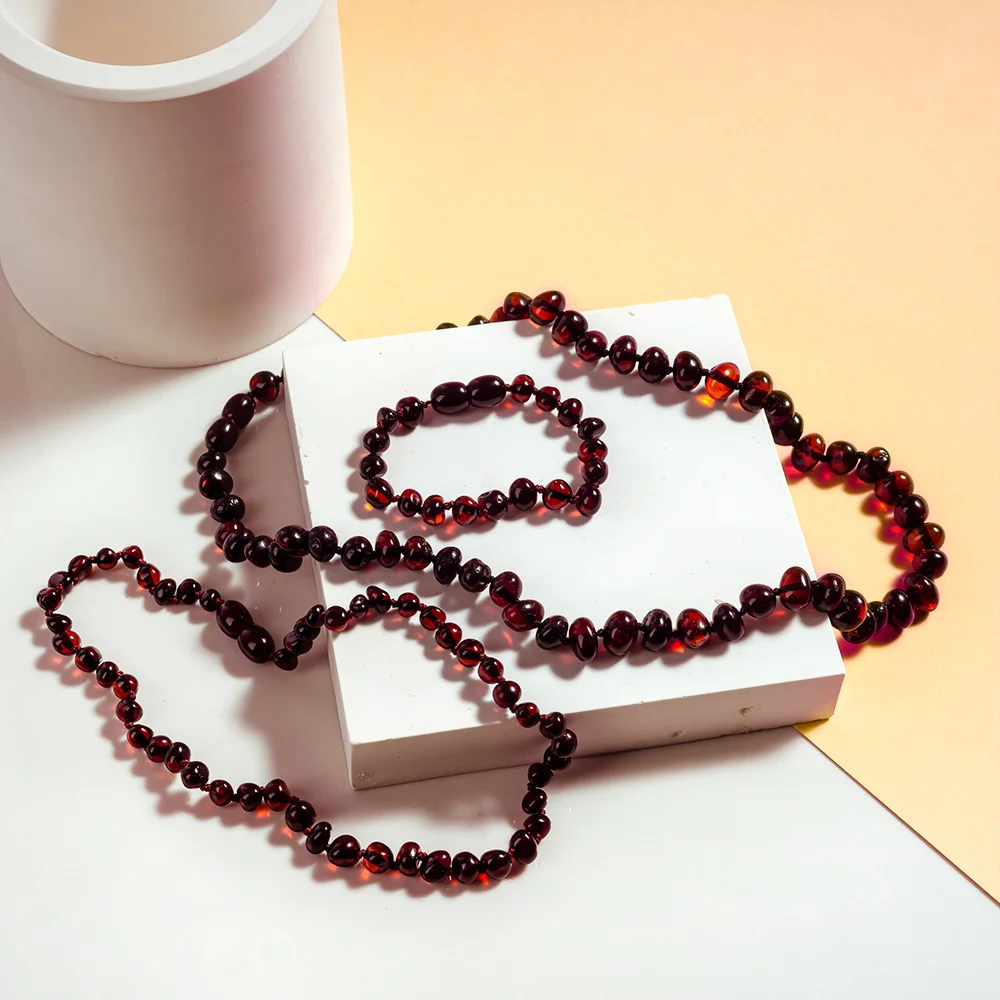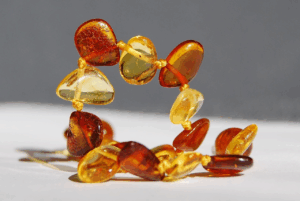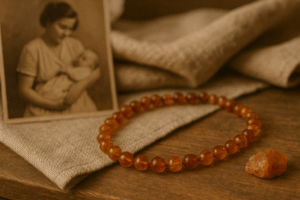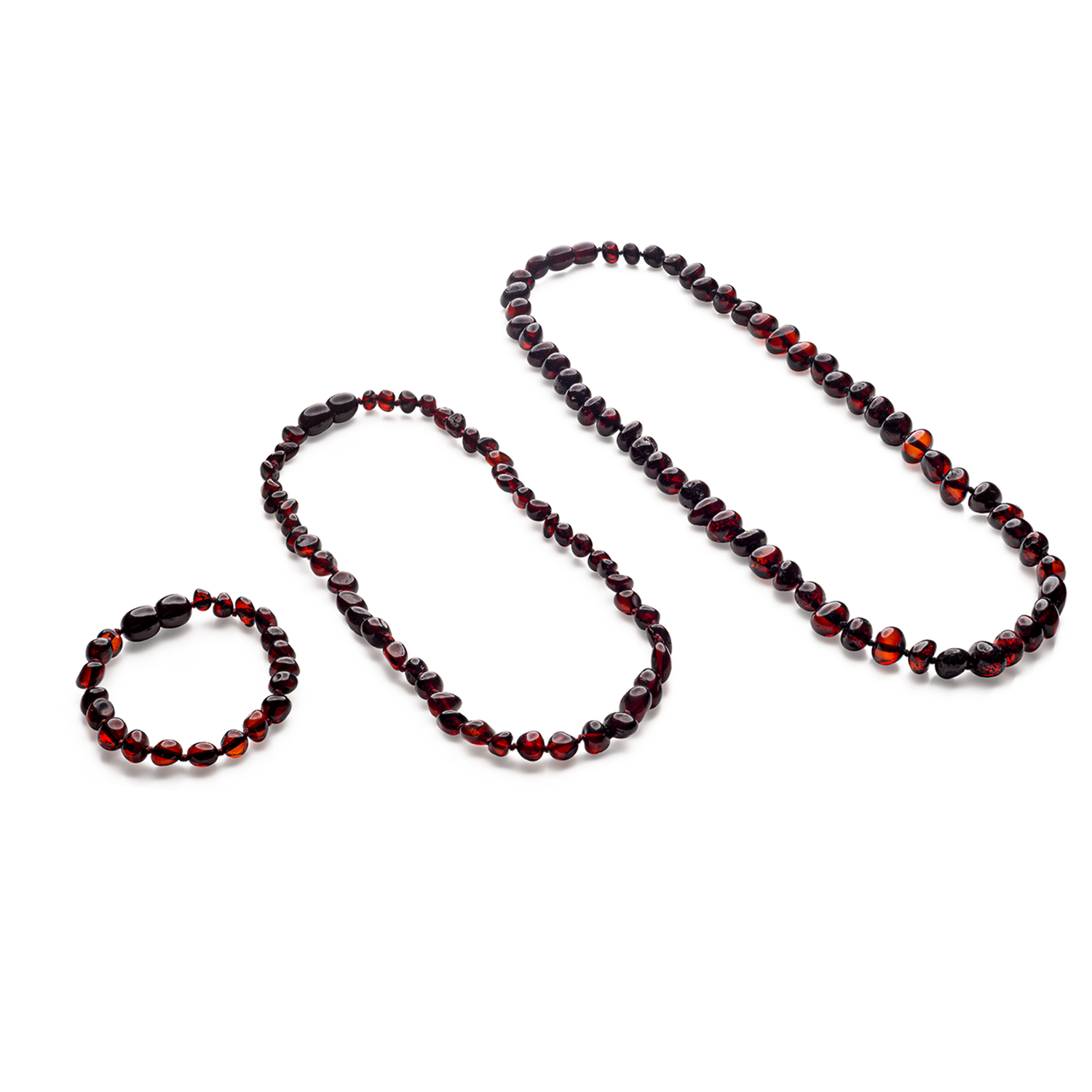It’s 3 a.m., and your baby is awake again, cheeks flushed, fists in their mouth, crying from the ache of new teeth breaking through. You’ve tried the cold washcloth, teething rings, even those late-night car rides. Somewhere between rocking your baby and scrolling for help in a sleep-deprived haze, you stumble across amber teething necklaces and wonder:
How long does it take for amber to help with teething pain? Does it work right away? Will it make any difference at all?
At BalticProud, we know parents want clear, honest answers before trying something new for their baby. This guide will help you understand what Baltic amber is, how it’s believed to work, and what other parents have experienced when using amber necklaces for teething—so you can decide if it fits your family’s approach to comfort and care.
What Are Amber Teething Necklaces and How Do They Work?
Baltic amber is fossilized tree resin, treasured for centuries across Europe for its warm beauty and believed holistic properties. Unlike plastic or silicone teethers, amber teething necklaces are not meant to be chewed. Instead, they are worn against the baby’s skin, where the warmth of the body is thought to help release trace amounts of succinic acid, a substance found naturally in Baltic amber.
Supporters believe that this succinic acid may help with inflammation and discomfort, providing a gentle, natural approach to teething. While scientific studies are limited, many parents share stories of noticing calmer moods, reduced drooling, or milder fussiness when their babies wear Baltic amber teething necklaces regularly.
It’s important to remember that amber is not a medication, and results vary from baby to baby. However, for families who value holistic methods, amber necklaces are often part of a teething comfort toolkit used alongside other soothing techniques.
The Big Question: How Long Does It Take for Amber to Work?
Here’s the truth most parents want to know: amber teething necklaces do not work like flipping a light switch. You won’t see instant results the moment you place the necklace on your baby. Instead, if amber offers benefits for your child, you are likely to notice subtle changes over time.
Many parents who use Baltic amber teething necklaces report that it can take anywhere from a few days to a few weeks to notice differences in drooling, fussiness, or overall calmness. Some parents share stories of seeing small improvements within 3–5 days, while others note changes closer to the two-week mark.
How quickly amber might work depends on several factors, including:
- Consistency of wear (necklace needs to be in contact with the skin during waking hours).
- Your baby’s body chemistry and skin warmth.
- The quality and authenticity of the amber.
- The severity of your baby’s teething discomfort.
The key is realistic expectations. Amber, if it helps, often works gently, creating subtle shifts rather than dramatic overnight changes. In the next sections, we will explore whether amber teething necklaces work immediately, what signs to look for, and real stories from parents to help you decide if it’s worth trying for your baby.
Does Amber Teething Necklace Work Immediately?
If you’re hoping for instant relief the moment you clasp the amber necklace around your baby’s neck, it’s important to adjust expectations. Amber teething necklaces do not work immediately. Unlike a pacifier or a cool teething ring that can soothe discomfort in the moment, amber works—if it works for your baby—gradually.
Amber supporters believe that when the necklace is worn consistently, the warmth of your baby’s skin may help release trace amounts of succinic acid over time. This is why many parents keep the necklace on their baby during the day (with supervision) to ensure consistent skin contact. However, even among families who notice benefits, the changes are subtle, such as:
- Slight reduction in drooling.
- Shorter or less intense fussy periods.
- Improved daytime naps or calmer evenings.
If you expect an overnight fix, you may end up disappointed. Instead, view an amber teething necklace as part of a gentle, holistic approach to teething discomfort, best used alongside other comforting practices like gentle gum massages, chilled teethers, or extra cuddles.
Real Experiences: Parents Share Their Stories
When you’re exhausted from sleepless nights and teething tears, it helps to hear from other parents who have been in your shoes. While amber teething necklaces don’t work the same for every baby, many families choose to try them based on word-of-mouth experiences.
Emily, mom of an 8-month-old
“We didn’t see a difference right away, but after about a week, I realized my daughter was drooling less, and she seemed less restless in the afternoons. It’s subtle, but I’ll take any help I can get during teething!”
Carlos, dad of twins
“For one of our twins, the amber necklace didn’t seem to change much, but for the other, we noticed fewer teething meltdowns by day 5 or 6. We use it alongside teething toys, so it’s part of our routine now.”
Jenna, first-time mom
“I honestly tried it because my mom suggested it, and I liked the natural idea. After about 10 days, we noticed a calmer baby overall, but it’s hard to say if it was the amber or just that teething phase passing.”
These stories show that amber teething necklaces may offer small but meaningful relief for some babies, while others may not respond in the same way. It’s okay to observe your baby and decide what’s working best without pressure or guilt.
The Science and Tradition Behind Amber
For centuries, Baltic amber has been valued in European cultures for its beauty and believed healing properties. Historically, parents would tie small pieces of amber on string for babies, hoping it would help with teething discomfort and bring calm.
Today, the primary explanation shared by supporters is the presence of succinic acid in Baltic amber, which may have anti-inflammatory properties when absorbed in trace amounts through the skin. However, it’s important to know:
- Scientific evidence supporting succinic acid absorption and its impact on teething pain is limited.
- There are no medical claims that amber will stop teething pain.
- Many families choose amber necklaces as a gentle, traditional comfort measure alongside other methods.
What is clear is that genuine Baltic amber is a natural material, and many parents appreciate using it as part of a holistic, nurturing approach to teething. If you choose to try amber, prioritize authentic, responsibly sourced Baltic amber necklaces, and always supervise your baby while wearing them to ensure safety.
Signs That Amber Might Be Helping Your Baby
If you decide to try an amber teething necklace, it’s natural to watch closely for signs that it may be helping. Since amber’s effects are subtle, you won’t see dramatic, overnight changes, but many parents notice small shifts such as:
- Less drooling: You may find fewer soaked bibs or wet collars.
- Milder fussiness: Your baby may still have teething discomfort, but the crying spells may become shorter or less intense.
- Improved daytime naps: Some parents notice babies settle more easily for naps, possibly due to reduced discomfort.
- More settled mood: You may see a generally calmer demeanor during active play.
Remember that teething comes in waves, and babies may have better and worse days regardless of the necklace. If you see gradual improvements within a few days to two weeks, it may indicate your baby is responding positively.
Factors That May Affect How Quickly Amber Works
Not all babies will respond to amber in the same way, and how long it takes for amber to work, if it does, depends on several factors:
Consistency of wear: Amber necklaces work best when worn daily (with supervision), ensuring continuous skin contact. If your baby only wears it occasionally, any potential benefits may be too subtle to notice.
Skin contact and warmth: The warmth from your baby’s skin is believed to help release succinic acid from the amber. Ensure the necklace sits comfortably against the skin, not over thick layers of clothing.
Baby’s age and teething stage: Some babies begin teething at four months, others later. The stage of teething and your baby’s individual sensitivity to teething discomfort may affect how noticeable any changes are.
Quality of amber: Authentic Baltic amber contains the highest succinic acid content. Choosing genuine, high-quality amber necklaces is essential, as imitations will not offer the same potential benefits.
Body chemistry: Just as some adults find relief from certain natural remedies while others don’t, babies may respond differently depending on their body chemistry and sensitivity.
By understanding these factors, parents can approach using amber teething necklaces with realistic expectations, patience, and informed decision-making.
What If I Don’t See Any Results?
If you’ve used the necklace consistently for two to three weeks without noticing any differences in drooling, fussiness, or comfort, it’s possible your baby may not respond to amber. This does not mean you’ve failed or that the necklace was a poor choice—it simply means every baby is different.
Here’s what you can consider:
- Use as part of a holistic approach: Continue using other comfort methods, such as cold teethers, gum massages, or extra snuggles during teething flares.
- Check necklace quality and fit: Ensure your amber necklace is genuine Baltic amber and sits comfortably against the skin.
- Consider timing: Teething discomfort often comes in waves, so your baby’s relief may align with a natural easing of discomfort rather than the necklace alone.
It’s also important to supervise your baby while wearing the necklace and remove it during naps and bedtime to ensure safety. At the end of the day, your goal is to find what works best for your baby and your family, whether that includes Baltic amber or other soothing techniques.
Addressing Myths and Facts About Amber Teething Necklaces
It’s easy to find conflicting opinions online about amber teething necklaces. Let’s clarify some common myths and facts:
Myth: Amber teething necklaces work instantly.
Fact: If they help, it’s typically a gradual process taking days to weeks.
Myth: All babies will have the same results.
Fact: Responses vary widely, and some babies may not show noticeable changes.
Myth: Amber teething necklaces can replace all other teething comfort methods.
Fact: They are best used as part of a holistic comfort plan.
Myth: Amber necklaces are unsafe.
Fact: With proper supervision, correct sizing, and removal during sleep, they can be used safely. Parents must always follow safety guidelines.
Understanding these points helps parents approach Baltic amber with realistic, balanced expectations while prioritizing safety.
Frequently Asked Questions
How long does it take for an amber teething necklace to work?
If it offers benefits, most parents notice changes within a few days to two weeks.
How will I know if the amber necklace is helping?
Watch for reduced drooling, milder fussiness, and calmer moods, especially during known teething flare-ups.
Can my baby sleep with the necklace on?
No. Always remove the necklace during naps and sleep for safety.
Does the color of amber affect how fast it works?
Raw amber (unpolished) is often believed to have higher succinic acid content, but there is no clear evidence that color alone impacts effectiveness.
How do I know if my necklace is genuine Baltic amber?
Buy from reputable sources like BalticProud, check for authenticity guarantees, and ensure you receive lab-tested Baltic amber.
Safety and Responsible Use
While many parents use amber teething necklaces safely, it’s crucial to follow guidelines:
- Always supervise your baby when wearing the necklace.
- Remove the necklace during naps and bedtime.
- Choose the correct size to ensure a snug but comfortable fit.
- Regularly inspect the necklace for wear or damage.
Amber teething necklaces are not toys or teethers and should never be chewed on.
Should You Try Amber for Your Teething Baby?
Teething is a challenging milestone for both babies and parents. If you value holistic, natural approaches, trying a Baltic amber teething necklace can be a gentle addition to your comfort toolkit. While results vary, many families appreciate the potential subtle support amber may offer during the teething phase.
The key is to approach amber necklaces with realistic expectations, ensure safe use, and remember that your baby’s comfort and safety are the top priorities.
Ready to Try Baltic Amber for Your Baby?
Explore our collection of authentic Baltic amber teething necklaces, ethically sourced and crafted with care, at BalticProud.


